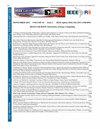基于机器学习的不均匀 WiFi 信号指纹定位框架
IF 1.3
4区 工程技术
Q3 COMPUTER SCIENCE, INFORMATION SYSTEMS
引用次数: 0
摘要
WiFi 指纹定位是确定室内位置的常用方法。现有方法在离线阶段容易受到 WiFi 信号强度波动的影响,导致接收到的信号不均匀。此外,在在线定位期间,缺乏与历史轨迹信息的整合。这些问题都会导致离线指纹采集和在线定位出现错误。为了解决这些问题,我们提出了一种方法,将离线阶段的常态检测和在线阶段的位置加权 K 近邻定位结合起来。在离线阶段,初始接收信号强度指示样本会经过基于偏度和峰度的预处理,以进行正态性检测。如果样本符合正态分布模型,则使用正态分布函数估算概率密度。如果不符合,则使用核密度函数模型进行估计。随后,在卡尔曼滤波后对数值进行平均,以建立高精度指纹数据库。在线定位阶段采用 LWKNN 算法。最初,加权 K 近邻法估计位置,并利用这些信息作为特征来构建长期和短期记忆网络模型。通过最小平方法确定最佳路径。最后,将获得的输出结果与指纹定位轨迹的历史数据相结合,以提高目标定位的准确性。实验结果表明,与传统定位方法相比,我们的室内定位方法显著提高了 WiFi 指纹定位精度。本文章由计算机程序翻译,如有差异,请以英文原文为准。
A fingerprint location framework for uneven WiFi signals based on machine learning
WiFi fingerprint positioning is a common method for indoor location determination. Existing methods are susceptible to fluctuations in WiFi signal strength during the offline phase, leading to unevenly received signals. Additionally, during online positioning, there is a lack of integration with historical trajectory information. These problems can result in errors in both offline fingerprint acquisition and online location positioning. To address these problems, we propose a method that combines normality detection in the offline phase and Location Weighted K-nearest Neighbor positioning in the online phase. In the offline phase, initial Received Signal Strength Indication samples undergo preprocessing based on skewness and kurtosis for normality detection. If the samples conform to a normal distribution model, the probability density is estimated using the normal distribution function. If not, estimation occurs using the kernel density function model. Subsequently, values are averaged after Kalman filtering to establish a high-precision fingerprint database. During the online positioning phase, the LWKNN algorithm is employed. Initially, the Weighted K-nearest Neighbor method estimates the position, and this information is utilized as features to construct a Longterm and Shortterm Memory network model. The optimal path is determined through the least square method. Finally, the obtained outputs are integrated with historical data from the fingerprint positioning trajectory to enhance target positioning accuracy. Experimental results demonstrate that our indoor localization method significantly improves WiFi fingerprint localization accuracy compared to traditional localization methods.
求助全文
通过发布文献求助,成功后即可免费获取论文全文。
去求助
来源期刊

IEEE Latin America Transactions
COMPUTER SCIENCE, INFORMATION SYSTEMS-ENGINEERING, ELECTRICAL & ELECTRONIC
CiteScore
3.50
自引率
7.70%
发文量
192
审稿时长
3-8 weeks
期刊介绍:
IEEE Latin America Transactions (IEEE LATAM) is an interdisciplinary journal focused on the dissemination of original and quality research papers / review articles in Spanish and Portuguese of emerging topics in three main areas: Computing, Electric Energy and Electronics. Some of the sub-areas of the journal are, but not limited to: Automatic control, communications, instrumentation, artificial intelligence, power and industrial electronics, fault diagnosis and detection, transportation electrification, internet of things, electrical machines, circuits and systems, biomedicine and biomedical / haptic applications, secure communications, robotics, sensors and actuators, computer networks, smart grids, among others.
 求助内容:
求助内容: 应助结果提醒方式:
应助结果提醒方式:


